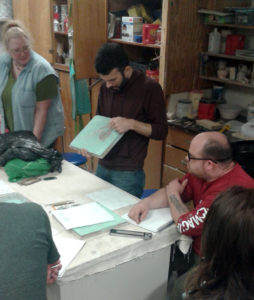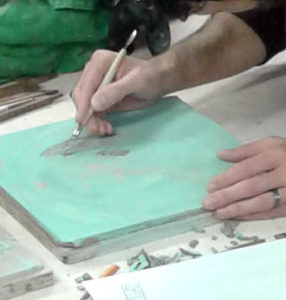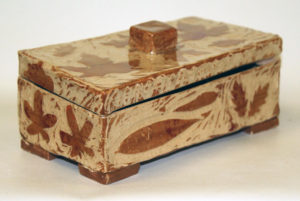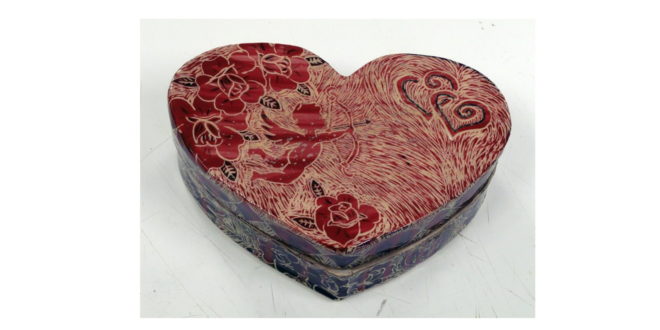Division of Visual Arts Chair Dana C. Tupa wanted to jolt her non-art students into getting past their fears and tapping into their creativity in her Underglaze Carving Ceramics class.
What better way than to have a colleague in the division learn the fine details of an unfamiliar art form right in front of them in class?
Nick McNally, Assistant Professor of Illustration, was more than willing. The “Quality Marks” project was born – and Tupa saw the confidence bloom in her students with a quickness and degree she’d never seen before.

“I sometimes see in my non-art majors that perhaps at some point in life they were discouraged,” Tupa said. “But I believe every human is creative. It can get switched off or redirected, however. And with the non-art majors, I often hear ‘I can’t,’ or ‘Please don’t make me draw.’”
The ceramics professor has collaborated on 30 art-based projects at JU, but a forum last semester in which College of Fine Arts artists joined together to discuss their professional methods and motivations with students provided the seed for her idea of a joint “live” effort done before a class.
Tupa is known for continually challenging the concept of media-specific technique with collaborative experiences aimed at broadening boundaries and crossing borders. As part of the class, Tupa joined with McNally to see what developments could be made when students were introduced to separate-yet-equal artistic skill sets for pictograms.
And, to drive the point home of creating joy and inspiration from working together, Tupa had McNally, a natural storyteller and admitted ponderer of historical tales, practice the ceramic technique of “sgraffito” that he’d been recently learning from her – right in front of her students’ eyes.
Contemporary sgraffito is the carving away or removal of coats of colored clay slips from leather-hard clay forms, Tupa said. A pointed tool or small metal loop is used to reveal layers beneath the colored surface.
In Tupa’s words, “sgraffito is neato … it literally means to write or to mark, but originates from calligraphy, beautiful marks. It became a popular form of surface decoration on clay wares in the 1500s.”

McNally, who is in his first year at JU, embraced the challenge, and he agrees there are similarities and differences in the two processes of making marks.
“Working with sgrafitto allowed me to join my illustration experience with a 3D media – a brand new combination for me,” he said.
When the students realized McNally hadn’t done this type of art form before, and that he was learning it, too, they began to become more self-assured, Tupa said.
“They could see he was no different from them, and it was really cool. They were processing the information very quickly, and they could not wait to finish the demo and start doing their own projects.”
Nursing student Rylie Ayles said the collaboration in class was interesting and informative.
“It was neat to watch how an artist took on a new project in front of the class and experienced it for the first time, just like how we will be.”
“During my demo, I was impressed with the students’ questions and comments. They’re an energetic group – eager to learn and eager to get their hands dirty,” McNally said.
Tupa’s first collaborative exchange at JU was with a Marine Science Ichthyology class 11 years ago, and she wanted to share with her students that particular feeling of courage and innovation that comes only when trading expertise and knowledge with others.

“Working with Nick was really great because he brought an alternative perspective on mark-making to the table.” Tupa said. “He spoke about the concept as being like a puzzle, where fitting positive shape with negative line would generate a quality stroke and collectively feed students’ narratives.”
Lamar Jackson, Chemistry major, summed up the experience by saying: “This class breaks down the barriers between fear and confidence. Truly an amazing experience.”
What was remarkable to Tupa was the leap in self-assurance and artistic ability the class of non-art majors made.
“I’ve been teaching for over 20 years and this is one of the first times I have experienced such a quick transition from the typical ‘I can’t’ student to the confident ‘Sure-I-can-once-I-decide-what-I-want-to-say’ student,” she said. “I think bringing in Nick’s perspective had something to do with that. They ran with it.”
 Wave Magazine Online Jacksonville University News Hub
Wave Magazine Online Jacksonville University News Hub
